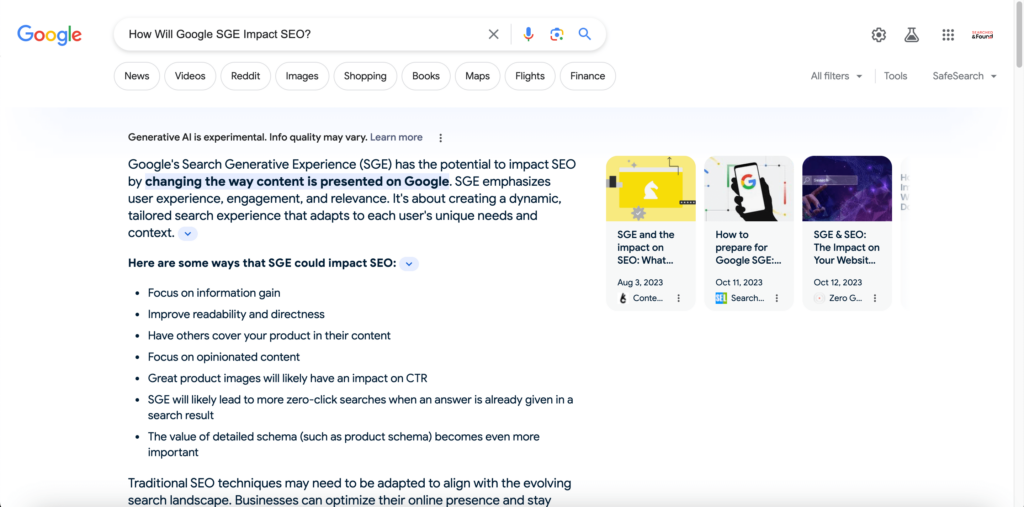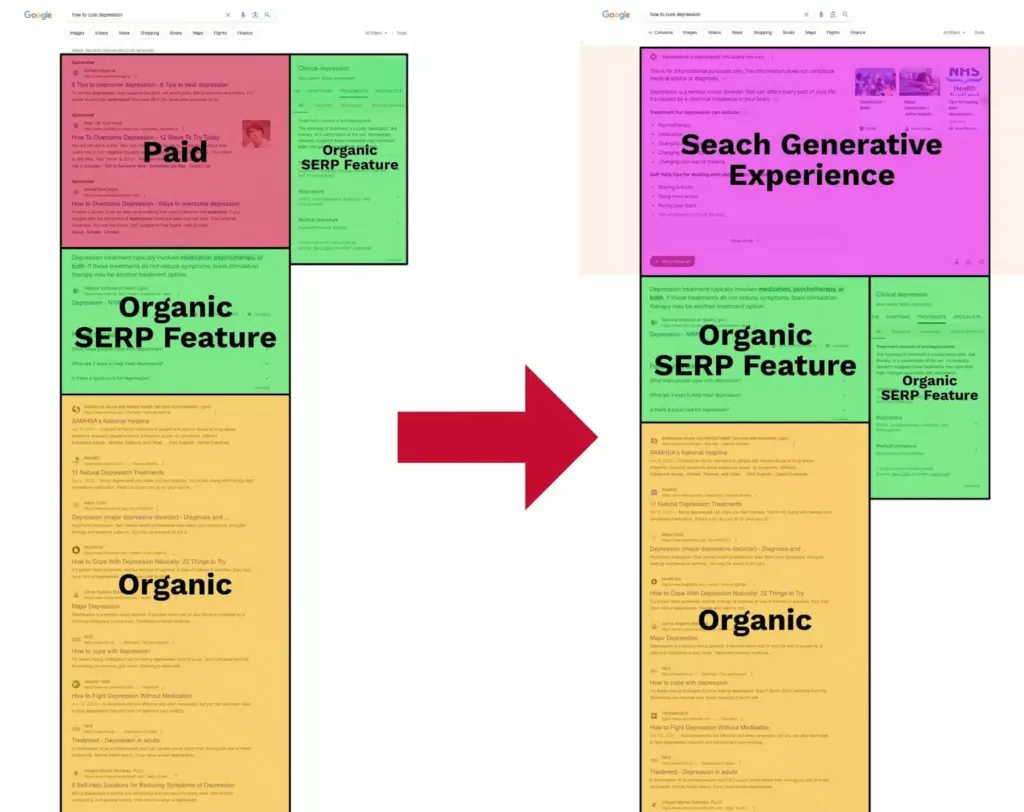
In May 2023, Google announced at its annual Google I/O developer conference that it is giving Google Search Labs users an opportunity to sign up and test a new AI-powered search feature called Search Generative Experience (SGE). Currently, SGE is only available in the US, and the only language is English.
According to Google, “SGE brings the power of generative AI directly into Google Search. The new Search experience helps you quickly find and make sense of information. As you search, you can get the gist of a topic with AI-powered overviews, pointers to explore more, and ways to naturally follow up.”
Until now, Google Search has been powered by processes deploying web crawlers, which visit websites and collect and index the information they find. From there, Google’s search engine algorithms rank the search results. In contrast, SGE does not rely on indexed data. Instead, it employs AI for content and queries. Instead of simply presenting ranked results, SGE uses AI to infer results, make suggestions, and provide better search results.
So, when a user selects one of SGE’s suggestions, they experience what’s called conversational mode, making the search experience like an interaction with a chatbot such as ChatGPT. In this mode, users continue to explore their search topic, refining it as they go without having to retype part or all of the original query.
As Google rolls out these changes, they will undoubtedly impact how users interact with Search. That, in turn, will impact SEO – how and to what degree remains to be seen. SEOs will have to monitor and adapt to the changes as they come to keep their SEO strategies up to date. All of the many predictions must remain educated guesses for now. What you can do is understand what SGE is and how to prepare and optimize your SEO as more features come online.

SGE Explained
Despite the flurry of recent discussion, AI in SEO is not new. SEO marketers have used AI for insights and automation for years. The reason for the surge of interest is the introduction of ChatGPT and Generative AI, of which SGE is one of the newest innovations.
SGE is a new AI-powered feature that expands Google’s Search experience with additional features. The goal is to give users more comprehensive results with a single search. Searchers can now ask more complex, detailed questions and receive more personalized answers. The Search Engine Results Page (SERP) will include relevant information and links grouped in an interactive summary. Google has dubbed this summary as a Snapshot. The Snapshot replaces Google’s well-known position zero, known as its “featured snippet” SERP ranking, which uses AI to place the most relevant matches there per the searcher’s intent.
In addition to the new SERPs Snapshot presentation, searchers can ask conversational-style follow-up questions and generate texts as though they are interacting with AI chatbots like ChatGPT. So, the more detailed the user’s query is, the more customized the Snapshot becomes. For instance, if users were to type “best automated robotic vacuum,” they would receive a broad list of results. Now, however, the user can enter more detailed queries like “best automated robotic vacuum for pets and hardwood floors.” The resulting Snapshot would be more precise and targeted to the specific keywords.
Similar to the featured snippet, Google’s Generative AI Snapshot gives users a brief overview of a complex topic and then provides an option to explore using provided source thumbnails. The Snapshot feature is powered in three parts by Google’s Large Language Model (LLM), Multitask Unified Model (MUM), and PaLM 2 general-purpose model. These models aid in identifying multiple types of content and media.
The results showcase selected products, topics, and services as applicable. The priority is on experience-driven results and authoritative recommendations. As AI evolves, this may include perspectives from experts with established authority and trust. This added Perspectives feature enables users to select filters to continue their research, accessing varied views from multiple channels like social media and boards. For the first time, search results will include information based on deep knowledge of a subject and first-hand experience.


How SGE Impacts SEO
Google is taking a long-term, experimental approach to AI. As mentioned, Google is providing access to SGE and other emerging AI technologies via its Search Labs, which is available in the United States only at this time. Because SGE is in the early stages, there’s no precise prediction on how it will impact SEO.
What we do know is that SGE means shifting to a new, AI-driven interface where people engage by asking conversational questions, viewing a brief overview of a topic, and actually generating creative ideas and potential drafts within the interface. This will trigger an evolution with the SERP, requiring SEO professionals to recognize, accept, and embrace AI tools and technologies.
Google has stated that Search AD will work similar to before in that ads will appear in a separate section within the user interface. While that’s something, it doesn’t explain how or if SGE changes website ranking or how to optimize your content to function best on this new channel. In addition, the AI-enhanced Search experience will influence user behavior almost by design. Thus far, there have been mixed reactions to AI technologies. Further, impacts on user behavior will, in turn, affect organic search results in ways we have yet to assess.
Impacts on User Behavior
Because SGE summarizes multiple sources together, users can find what they are looking for with fewer queries. As a result, they won’t necessarily scroll past the SERP to visit additional websites. Younger users are likely to adapt to this new model relatively quickly. As others become familiar with generative AI search technology, they are less likely to search any other way.
While some users will be satisfied with the condensed information offered in the Spapshot, others will ask more follow-up questions and take advantage of SGE’s in-depth queries and tailored results. Thus, SEO will focus on both types of search intent.
SGE Impacts on Organic Traffic
SGE curates information during the search experience in a very specific way. Due to this, some theorize that it will reduce human interaction with sponsored links and organic search results. Within this context, organic means “non-AI-generated.” Soon, however, SGE’s AI-driven results will appear in organic searches. While SGE bases its results on authority and relevance, it’s unclear as to how it determines those criteria. However it calculates it, there will be a shift toward domain authority and quality content. Most would agree that’s a good thing; however, marketers should pay attention now and theorize how to modify their SEO strategies to adapt to SGE.
For example, SEO analysts may need to move away from keyword-driven content and focus on searchers looking to find information from differing perspectives. That’s a huge paradigm shift, to say the least.
Impacts Across Industries
As AI-generated platforms become more mainstream, SEO becomes more essential across industries. SEOs already possess specialized skills that make them desirable for any organization’s marketing toolbox. This makes them consultants across channels, platforms, and industries. The client organization relies on them to understand their particular market and SEO principles as a whole.
Thus, SEO providers deliver critical business intelligence to help organizations understand the competitive landscape and compete successfully. Given how fast AI is gaining ground, the SEO strategist’s job is to provide real-time insights into what is happening in markets and SEO. And, that means understanding SGE and its focus on user intent as it relates to conversational search.
We have already discussed how SGE works. Now, understand that SEO is no longer a niche unto itself. It is becoming a universal wealth of business intelligence insights. The resulting data will drive everything from updating websites to creating content and media campaigns. Google’s new experience will influence the success of all marketing efforts beyond content and search. It will aid in the analytics surrounding brand awareness and development, products, public relations communications, and social media.

How to Leverage SGE Advantages
Emerging technologies like SGE require SEO professionals to examine how they currently approach SEO and expand their strategies to include AI-driven tools. Understanding and adapting to new technologies is vital to remaining competitive and keeping those content rankings high.
Optimizing content for AI-powered search engines is one of the most critical ways to adapt to the changing digital marketing landscape. SGE is here, so it’s time to explore new SEO techniques that take advantage of SGE’s capabilities. Here are some guidelines:
Keep the focus on quality and domain authority.
The SGE Snapshot promises to become a primary source for information searches, likely resulting in an overall decline in SERP click-through rate (CTR). More searchers will begin and end their search in the Snapshot, never clicking away from the SERP.
What are the implications? This means your content will have to maintain strong domain authority so that it lands in the SGE Snapshot. Building authority means earning backlinks and ensuring your content is high quality and adds legitimate value to the user. Doing so makes your content more likely to be linked to by other sites. So, rather than providing quick answers, your content should become more focused and detailed and offer comprehensive information for those searching the topic.
Group content to address various search journeys.
More than just writing more content, it’s important to group your content to respond to the type of queries SGE generates. To do this, break your content into topics and subtopics with headings that Google can spot. This is in direct contrast to the “ultimate guide” posts we are used to seeing. While you can still provide those guides, you’ll want to create subtopics that link out to explore those topics in greater detail.
Consider all the possible questions that users could ask and tailor your content accordingly. Remember, now they can ask in conversational style rather than keyword phrases. SGE results can focus on highly detailed search queries.
Optimize for conversational speech.
As discussed, SGE bases results on authentic conversation exchanges (interactions) due to its chatbot nature. Thus, your content should be structured around this new form of search intent. Rather than independent keywords or phrases, you’ll need to target more long-tail keywords that reflect the questions and interactions happening in the SGE search. The search can go deeper quickly; you’ll need to optimize with that in mind.
How do you accomplish this? Take time to identify the possible and follow-up questions users may ask during their search. Keywords are still important; only now, you’ll be thinking about how they fit into dialog-type search strings from your target audience.
Optimize for user engagement.
Among the many expert predictions for SGE, it’s projected that engagement metrics such as pages viewed and time on page will influence which content Google places on the Snapshot.
We don’t yet understand how the metrics will fall for AI-driven search; however, you can keep this in mind when enhancing your current content’s engagement performance.
One way to do this is to present your content in multiple formats, with the goal of meeting various audience preferences. For example, you can include videos or infographics along with textual content. Your overall graphics should be high-quality, engaging, and relevant with the proper metadata. This includes thumbnails and index graphics.
You can also interlink your content to promote more click-throughs. These interlinks align with the content clustering we discussed earlier. Finally, don’t overlook the technological optimization to keep load speeds down and your mobile optimization up.
Preparing for a Future AI-Curated Search Experience
At present, SGE is in its infancy, and its use is limited. Google has released it as experimental to users who sign up through Google Search Labs. In its current state, criticisms abound, some of that is fueled by a general mistrust of AI. However, Google is adapting, modifying, and enhancing its capabilities constantly. What we have presented here is an overview of this technology and some general predictions. We also included some practical approaches to keeping SEO updated as SGE and other AI-driven search tools come online and reshape Search.
Content quality and domain authority remain paramount, and keywords hold their value. The modifications come with understanding the conversational style and deeper structure of both search queries and SGE’s structured search results. The Snapshot provides information that may satisfy the users without clicking through to the listed websites. It also provides curated opportunities for users to click links to dig deeper.
For SEOs, that means adapting to this new conversational style. We must focus on optimizing for user engagement. In addition, we must rethink how we structure content, develop long-tail keywords, and cluster information to match the more complex queries SGE generates.